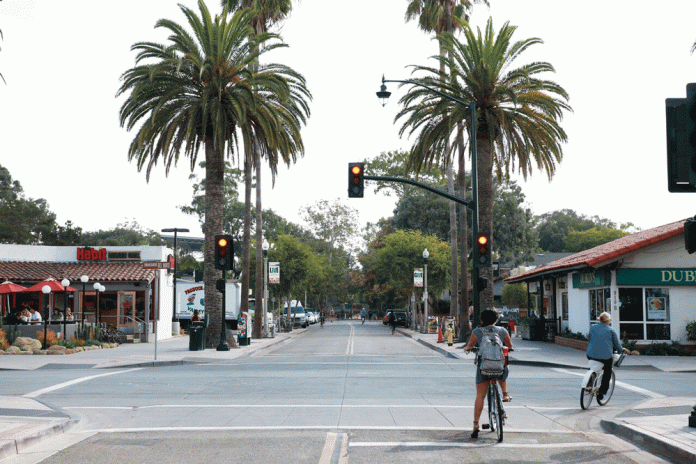Lauren Marnel Shores
Campus Beat Reporter
A new stoplight at the intersection of Pardall Road and Embarcadero Del Norte — installed over the summer — has prompted a mixed response among the University of California, Santa Barbara student community.
The Santa Barbara Public Works Department (PWD) installed the traffic signal at the intersection over the summer, in an effort to regulate traffic safety at one of Isla Vista’s busiest traffic spots.
The traffic light is set to a fixed time cycle, where cars, pedestrians, and cyclists will only have to wait 20 seconds until the next green light. Anu Polisetty, a second year computer science major, said she felt the short duration of the light helps regulate safety at the crosswalk rather than the level of traffic.
“I thought that it was really cool they put it up,” Polisetty said. I don’t know if it’s necessary, but it’s beneficiary. I’m glad they put it up. It makes driving a lot easier.”
The county cited a “disproportionately high number of collisions” as a reason to build the signal, according to an informational page on the PWD website.
“Given the high volume of reported collisions at this intersection (and it is suspected that collisions here are vastly underreported), Public Works and the County found that taking no action was unacceptable,” reads a Facebook post on Pardall Signal, a PWD-run page.
The county considered other options to decongest traffic, including a roundabout or a four-way stop. But the roundabout was deemed impractical because of space restrictions, and a four-way stop sign was considered insufficient because of a “culture of cyclists not stopping at stop signs,” the post reads.
Nay Lwin, a second year biology major, had positive comments for the new light as a regular driver in I.V., saying she hopes other areas in I.V. could use more traffic regulation.
“For me personally, when I drive my car, it’s really hard to see oncoming traffic,” Lwin said. “So the street light makes me feel more secure when I’m driving, as well as when I’m biking and boarding. I feel like the addition of more street lights would be beneficial to I.V. in general.”
Lwin noted that the lack of bicycle regulation allows bike-riders to “come and please as they go.”
“As a driver, you have to be very watchful,” she said, “because if you hit a biker or anyone else, the person driving usually takes the liability. For me as a driver, I found it very difficult to drive through I.V.,” Lwin said.
On the other hand, the newfound regulation of traffic has annoyed some bikers, who previously used Pardall Road to get home when leaving campus every day.
“Bikers ruled I.V.,” said Richa Wadaskar, a second year computer science major. “That street light is in our way.” She noted that many bikers feel frustrated, especially because no other stops in I.V. have traffic signals of their own.
“It’s one of the busiest roads in all of I.V. because it’s a direct link between campus and I.V. Everyone uses that. Or at least everyone used to,” Wadaskar said.
Alex Kamak, a second year dance and psychology double major, explained that she used to always bike home through Pardall, but now actively avoids the road because of the traffic signal.
“We might warm up to it, but because it’s something new, I just feel like people find it annoying since they’ve never had to deal with it before,” Kamak said.
Although some cyclists still choose to bike down Pardall and ignore the traffic signal, the county has warned that it will be enforcing the California Vehicle Code (CVC) and issuing citations to anyone violating the signal. According to the CVC, violation of Section 22450(a), failure to stop can result in tickets over $200 for a first offense.
California Highway Patrol (CHP) Captain Cindy Pontes explained that CHP will provide a short grace-period for the first two weeks of school to allow people to adjust to the new traffic light.
“However, officers still have the ability to issue citations for any violation they deem appropriate during that timeframe,” she said.
Though frustrated by the new light, Kamak defended the law enforcement, saying that the county might as well go “all out” if it wants to regulate traffic.
“I don’t know if it will work, but it’s the best option for now,” Kamak said. “We’ll see how it works.”











